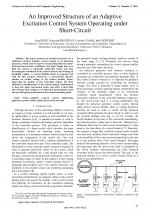| 2/2016 - 6 |
An Improved Structure of an Adaptive Excitation Control System Operating under Short-CircuitFILIP, I. |
| View the paper record and citations in |
| Click to see author's profile in |
| Download PDF |
Author keywords
adaptive control, control engineering, generators, power system faults, short circuit currents
References keywords
control(21), induction(10), generator(8), variance(7), tuning(7), systems(7), short(7), power(7), minimum(7), filip(7)
Blue keywords are present in both the references section and the paper title.
About this article
Date of Publication: 2016-05-31
Volume 16, Issue 2, Year 2016, On page(s): 43 - 50
ISSN: 1582-7445, e-ISSN: 1844-7600
Digital Object Identifier: 10.4316/AECE.2016.02006
Web of Science Accession Number: 000376996100006
SCOPUS ID: 84974782549
Abstract
The paper presents an extended structure for a minimum variance adaptive control system of an induction generator, which aims to improve its operating behavior under electrical short-circuit conditions. The basic design idea is to limit the control to physically achievable values, and thus increasing the robustness of the control system and avoiding an instability regime. A control limiting block is proposed and used for this purpose. Moreover, a short-circuit detector enables an on-line setting of the control penalty factor, improving the quality of the controlled output. All these additional customizations of the control system, implemented to keep the plant operational under and after a short-time short-circuit fault (acting as an abnormal perturbation), must also provide good performance in the normal operating mode. |
| References | | | Cited By |
Web of Science® Times Cited: 6 [View]
View record in Web of Science® [View]
View Related Records® [View]
Updated today
SCOPUS® Times Cited: 9
View record in SCOPUS® [Free preview]
View citations in SCOPUS® [Free preview]
[1] Tuning the control penalty factor of a minimum variance adaptive controller, Filip, Ioan, Szeidert, Iosif, European Journal of Control, ISSN 0947-3580, Issue , 2017.
Digital Object Identifier: 10.1016/j.ejcon.2017.04.005 [CrossRef]
[2] Considerations about Parameters Estimation into a Minimum Variance Control System, Filip, Ioan, Dragan, Florin, Szeidert, Iosif, Applied Sciences, ISSN 2076-3417, Issue 13, Volume 11, 2021.
Digital Object Identifier: 10.3390/app11136165 [CrossRef]
[3] Self-tuning strategy for a minimum variance control system of a highly disturbed process, Filip, Ioan, Vasar, Cristian, Szeidert, Iosif, Prostean, Octavian, European Journal of Control, ISSN 0947-3580, Issue , 2019.
Digital Object Identifier: 10.1016/j.ejcon.2018.06.004 [CrossRef]
[4] Design Options for Current Limit and Power Limit Circuit Protections for LDOs, PLESA, C.-S., DIMITRIU, B., NEAG, M., Advances in Electrical and Computer Engineering, ISSN 1582-7445, Issue 1, Volume 19, 2019.
Digital Object Identifier: 10.4316/AECE.2019.01008 [CrossRef] [Full text]
[5] Minimum-Variance Control System with Variable Control Penalty Factor, Filip, Ioan, Dragan, Florin, Szeidert, Iosif, Albu, Adriana, Applied Sciences, ISSN 2076-3417, Issue 7, Volume 10, 2020.
Digital Object Identifier: 10.3390/app10072274 [CrossRef]
[6] Tuning of a Minimum Variance Control System Based on the Estimated Process Gain, Filip, Ioan, Prostean, Octavian, Szeidert, Iosif, Bordeasu, Dorin, Vasar, Cristian, 2023 IEEE 17th International Symposium on Applied Computational Intelligence and Informatics (SACI), ISBN 979-8-3503-2110-4, 2023.
Digital Object Identifier: 10.1109/SACI58269.2023.10158537 [CrossRef]
Disclaimer: All information displayed above was retrieved by using remote connections to respective databases. For the best user experience, we update all data by using background processes, and use caches in order to reduce the load on the servers we retrieve the information from. As we have no control on the availability of the database servers and sometimes the Internet connectivity may be affected, we do not guarantee the information is correct or complete. For the most accurate data, please always consult the database sites directly. Some external links require authentication or an institutional subscription.
Web of Science® is a registered trademark of Clarivate Analytics, Scopus® is a registered trademark of Elsevier B.V., other product names, company names, brand names, trademarks and logos are the property of their respective owners.
Faculty of Electrical Engineering and Computer Science
Stefan cel Mare University of Suceava, Romania
All rights reserved: Advances in Electrical and Computer Engineering is a registered trademark of the Stefan cel Mare University of Suceava. No part of this publication may be reproduced, stored in a retrieval system, photocopied, recorded or archived, without the written permission from the Editor. When authors submit their papers for publication, they agree that the copyright for their article be transferred to the Faculty of Electrical Engineering and Computer Science, Stefan cel Mare University of Suceava, Romania, if and only if the articles are accepted for publication. The copyright covers the exclusive rights to reproduce and distribute the article, including reprints and translations.
Permission for other use: The copyright owner's consent does not extend to copying for general distribution, for promotion, for creating new works, or for resale. Specific written permission must be obtained from the Editor for such copying. Direct linking to files hosted on this website is strictly prohibited.
Disclaimer: Whilst every effort is made by the publishers and editorial board to see that no inaccurate or misleading data, opinions or statements appear in this journal, they wish to make it clear that all information and opinions formulated in the articles, as well as linguistic accuracy, are the sole responsibility of the author.





